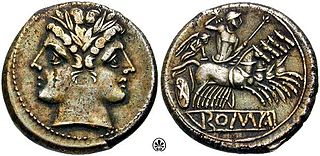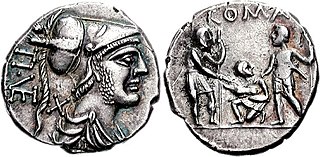
Marcus Servilius Pulex Geminus was a Roman statesman during the Second Punic War, and the early decades of the second century BC. He was a renowned warrior, whose martial prowess was commemorated on coins issued by several of his descendants.

Marcus Servilius Pulex Geminus was a Roman statesman during the Second Punic War, and the early decades of the second century BC. He was a renowned warrior, whose martial prowess was commemorated on coins issued by several of his descendants.
Servilius was the younger son of Gaius Servilius Geminus, praetor about 220 BC, and grandson of Publius Servilius Geminus, consul in 252. The Servilii Gemini were a branch of an old and distinguished patrician family, but either Gaius or his sons went over to the plebeians, for reasons that are not entirely clear. Servilius' elder brother, Gaius, was tribune of the plebs in 211 BC, consul in 203, and dictator in 202. Servilius' additional surname, Pulex, refers to a flea, but the circumstances of this cognomen are not mentioned in any source. [2]
Servilius was augur in 211 BC, curule aedile in 204, magister equitum in 203, and consul in 202. [3] [4] During his consulship, he was assigned to Etruria with two legions; in 201 his imperium was prorogued, and he remained in Etruria as proconsul. [5]
In 167 BC, during the debate whether to grant a triumph to Lucius Aemilius Paullus, Geminus addressed the people in favor of Paullus, showing his multiple scars earned in battle in order to impress the crowd. Indeed, Servilius was especially known for his dueling abilities, as he allegedly defeated twenty-three enemies in single combat. [6] [7] Five of his descendants who served as triumviri monetales depicted him on their coins. [8]
Servilius was probably the father of Marcus Servilius, one of the military tribunes in 181 BC, who was appointed pontifex in 170. The Vatiae, a plebeian family of the Servilii, including several of the moneyers whose coins depict Marcus Servilius Pulex Geminus, are thought to be descended through this line. [9]

Year 216 BC was a year of the pre-Julian Roman calendar. At the time it was known as the Year of the Consulship of Varro and Paullus. The denomination 216 BC for this year has been used since the early medieval period, when the Anno Domini calendar era became the prevalent method in Europe for naming years.

The gens Atilia, sometimes written Atillia, was a plebeian family at ancient Rome, which rose to prominence at the beginning of the fourth century BC. The first member of this gens to attain the consulship was Marcus Atilius Regulus, in 335 BC. The Atilii continued to hold the highest offices of the state throughout the history of the Republic, and well into imperial times.

Gaius Servilius Ahala was a 5th-century BC politician of ancient Rome, considered by many later writers to have been a hero. His fame rested on the contention that he saved Rome from Spurius Maelius in 439 BC by killing him with a dagger concealed under an armpit. This may be less historical fact and more etiological myth, invented to explain the Servilian cognomen "Ahala"/"Axilla", which means "armpit" and is probably of Etruscan origin.

The quadrigatus was a medium-sized silver coin produced by the Roman Republic during the 3rd century BC. The obverse featured a young janiform bust and the reverse featured Victory driving a quadriga, giving the coin its Roman name, with the inscription "ROMA" below.
Roman Republican currency refers to the Coinage struck by the various magistrates of the Roman Republic, to be used as legal tender. In modern times, the abbreviation RRC, "Roman Republican Coinage" originally the name of a reference work on the topic by Michael H. Crawford, has come to be used as an identifying tag for coins assigned a number in that work, such as RRC 367.

Lucius Minucius Esquilinus Augurinus was a Roman politician in the 5th century BC, consul in 458 BC, and decemvir in 450 BC.
Marcus Atilius Regulus, a son of Marcus Atilius Regulus, the consul captured during the First Punic War, and a grandson of Marcus Atilius Regulus, was a Roman consul for the year 227 BC, together with Publius Valerius Flaccus, and was a consul suffectus in 217 BC, replacing Gaius Flaminius, who was killed in battle at Lake Trasimene.
The gens Aelia, occasionally written Ailia, was a plebeian family in Rome, which flourished from the fifth century BC until at least the third century AD, a period of nearly eight hundred years. The archaic spelling Ailia is found on coins, but must not be confused with Allia, which is a distinct gens. The first member of the family to obtain the consulship was Publius Aelius Paetus in 337 BC.

Gaius Servilius Vatia was a politician of the Roman Republic in the second half of the 2nd century BC.
Quintus Marcius Philippus was a Roman consul in 186 BC and 169 BC.

The gens Postumia was a noble patrician family at ancient Rome. Throughout the history of the Republic, the Postumii frequently occupied the chief magistracies of the Roman state, beginning with Publius Postumius Tubertus, consul in 505 BC, the fifth year of the Republic. Although like much of the old Roman aristocracy, the Postumii faded for a time into obscurity under the Empire, individuals bearing the name of Postumius again filled a number of important offices from the second century AD to the end of the Western Empire.

The gens Antistia, sometimes written Antestia on coins, was a plebeian family at ancient Rome. The first of the gens to achieve prominence was Sextus Antistius, tribune of the plebs in 422 BC.
The gens Servilia was a patrician family at ancient Rome. The gens was celebrated during the early ages of the Republic, and the names of few gentes appear more frequently at this period in the consular Fasti. It continued to produce men of influence in the state down to the latest times of the Republic, and even in the imperial period. The first member of the gens who obtained the consulship was Publius Servilius Priscus Structus in 495 BC, and the last of the name who appears in the consular Fasti is Quintus Servilius Silanus, in AD 189, thus occupying a prominent position in the Roman state for nearly seven hundred years.

The gens Caedicia was a plebeian family at ancient Rome. Members of this gens first came to prominence in the early decades of the Republic, but none obtained the consulship until Quintus Caedicius Noctua in 289 BC. The family faded from public life during the later Republic, but one of the Caedicii was known to Juvenal, toward the end of the first century AD.

The gens Veturia, originally Vetusia, was an ancient patrician family of the Roman Republic. According to tradition, the armourer Mamurius Veturius lived in the time of Numa Pompilius, and made the sacred ancilia. The Veturii occur regularly in the Fasti Consulares of the early Republic, with Gaius Veturius Geminus Cicurinus holding the consulship in 499 BC. Like other old patrician gentes, the Veturii also developed plebeian branches. The family declined in the later Republic, with the last consular Veturius holding office in 206 BC, during the Second Punic War.

The gens Memmia was a plebeian family at ancient Rome. The first member of the gens to achieve prominence was Gaius Memmius Gallus, praetor in 172 BC. From the period of the Jugurthine War to the age of Augustus they contributed numerous tribunes to the Republic.
Gaius Servilius Geminus was a Roman statesman who served as Consul in 203 BC, Dictator in 202 BC, and Pontifex Maximus from 183 BC to 180 BC.
Gaius Servilius Geminus was a Roman senator. After holding the office of praetor, he in 218 BC was the member of a triumviral commission for the creation of the colonies of Placentia (Piacenza) and Cremona in Cisalpine Gaul. The Second Punic War against Carthage had just broken out, and the commissioners were surprised by an uprising of the Gallic Boii and Insubres, caused by news that the Carthaginian general Hannibal was approaching. Servilius and the others took refuge at Mutina, but were lured out and captured. For many years they were presumed dead, but Servilius survived and remained a prisoner, alongside his colleague Gaius Lutatius Catulus, for the next 15 years. They were released and returned to Rome in 203 BC by Servilius's son of the same name, who was consul that year.

The gens Fonteia was a plebeian family at ancient Rome. Members of this gens are first mentioned toward the end of the third century BC; Titus Fonteius was a legate of Publius Cornelius Scipio during the Second Punic War. The first of the Fonteii to obtain the consulship was Gaius Fonteius Capito, consul suffectus in 33 BC.
The gens Spurilia, sometimes spelled Spurillia, was an obscure plebeian family at ancient Rome. Hardly any members of this gens are mentioned by ancient writers, for the Spurilius mentioned in some manuscripts of Livy as tribune of the plebs in 422 BC is amended by some authorities to "Spurius Icilius", while it is uncertain whether the moneyer who issued denarii in 139 BC was named Spurius, Spurilius, or Spurinna. Nevertheless, a number of Spurilii are known from inscriptions.